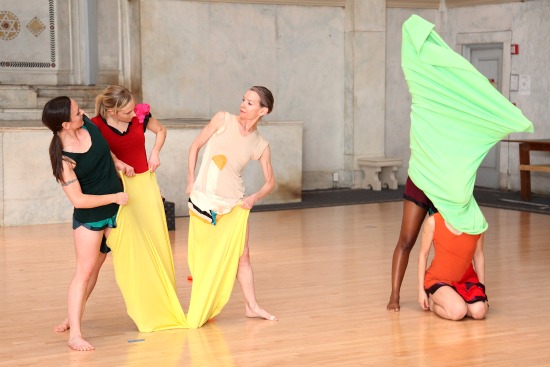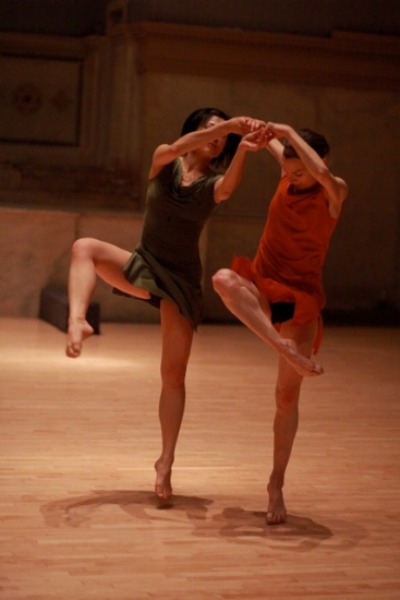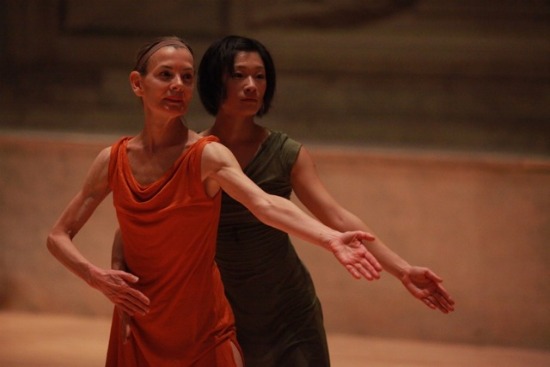In 2010, Molissa Fenley explored a new path, commissioning a number of artists to design props that could be manipulated by her and two additional dancers. Sometimes the results were striking, sometimes contrived. The newer Credo in Us, shown at Judson Church on January 9, goes way beyond The Prop Dance into a disciplined wildness and playfulness you might not have expected of Fenley—perhaps because this bold dancer-choreographer’s reputation rests in large part on the elegantly arduous, repetitively patterned solos she created for herself from 1988 to 1997.
Credo in Us takes its name, as well as the inspiration for its creative process, from John Cage’s 1942 composition, in which four musicians play muted gongs, tin cans arranged in order of approximate pitch, piano, electric buzzer, toms, phonograph, musical excerpts drawn from a radio, possibly more (check the several YouTube performances). A certain amount of indeterminacy figures, but absolute synchrony rules the many sudden stops. Cage wrote the delirious assemblage to accompany a duet that Merce Cunningham choreographed for himself and Jean Erdman (I like trying to imagine it).
Fenley’s Credo was commissioned by Mills College, the institution that awarded her a B.A. and where she now teaches part of the year. The piece premiered in Oakland this past September, and four of the six women who dance it in addition to Fenley are—or have been—students at Mills. She asked them to respond with lists of images conjured up by the music, culled the results, and bought props. The program lists the images; they range from the succinct (“Whispering, Chopping”) to the fanciful (“Meandering bee moving from flower to flower”). Khadda Madani provided an appropriate patchwork of costumes.
As the music (taped in this case) jumps from a heroic beginning (an extract of 19th-century symphonic music) to what sounds like a pots-and-pans skirmish infiltrated by a piano, the women begin to dance. Fenley’s movement style is distinctive, with little of the free flow or plushy resilience that’s often attributed (unreliably) to the influence of Skinner Releasing Technique. Her performers’ feet are active—hopping, sashaying, galloping, stepping into turns, lunging, striding. These women cover ground. Their arms, slicing or carving air, form shapes as precisely as do the gestures of an Indian Bharata Natyam dancer.
Credo in Us is primarily an enjoyable, occasionally silly, dance-filled game with props. Two large, shiny rectangles of cloth become (briefly) banners or cloaks. Other pieces of fabric take a turn as skirts. Metal bowls turn the dancers into helmeted warriors. For a while, a tube of stretchy cloth confines one of the performers (Judene Small, I believe), evoking Martha Graham’s famous 1931 Lamentation.Assistants placed in the audience exchange, say, bowls for forks or skillets, or produce orange traffic cones, while the six women form decorative clusters, brandish objects, and canter around, their faces intent and serious.
The Vessel Stories, a deeper and richer work, explores the possibilities ignited by Philip Glass’s gorgeous String Quartet #4 (1989). The music was commissioned by Fluxus artist Geoffrey Hendricks in memory of his partner, artist Brian Buczak, who died of AIDS in 1987. Decades later, Hendricks commissioned this dance as well. Both music and choreography have a gentle, but muscular lyricism. Only at times does Glass’s score fall into the familiar rhythmic-harmonic tropes that usually make his music instantly recognizable.
Fenley has also made a quartet (longtime Fenley dancer Paz Tanjuaquio and Small don’t appear in this). Costume designer Jill St. Coeur has aided the images of grave nymphs at play presented by the choreography by dressing the women in shortish tunics split up the sides. The seating areas at Judson Church can’t be kept dark, and lighting equipment is minimal, so David Moodey can’t create fancy effects, but, on the plus side, we’re in the same softly glowing environment as the four performers (Peiling Kao, Cassandra Neville, Rebecca Wilson, and Fenley).
The movement is echt-Fenley, but there’s a tenderness in the dancers’ gestures and the way these seem to originate deep in the spine. Occasionally the women pose in what might almost be ballet’s croisé devant stance, one pointed foot stretched on a diagonal, arms curved. But more often those arms are squared off and the four are traveling with the usual space-covering steps or a hand-in-hand chain that proclaims their sisterhood. And when a Fenley dancer lifts a leg high to the back, the move looks nothing like a classical arabesque; the raised leg, slightly bent and not turned out, calls to mind the original meaning of the word arabesque—a curving design suggesting foliage.
The piece is in three movements: “Faces of the Moon,” “100 Vessels,” and “Alcove of Treasures.” The middle of these is a duet for Fenley and Kao, set to Glass’s delicately poignant adagio. Kao is a wonderfully strong and eloquent dancer, and she and Fenley (now in her mid-fifties and leaner than ever) move beautifully together. The whole of The Vessel Stories is imbued with Fenley’s spare elegance in terms of form, the tensile strength of her movements, and an almost joyous, relieving attack on space—as if she had acres she could cover if she had a mind to.




What a brightly colored read your prose provides on a wet and dreary day on the west coast, where Fenley, like Cunningham, like Morris, like Joffrey, like Trisha, like Graham, like De Mille, like Duncan…received her early training. Many thanks.